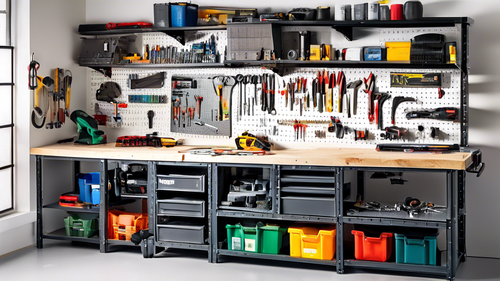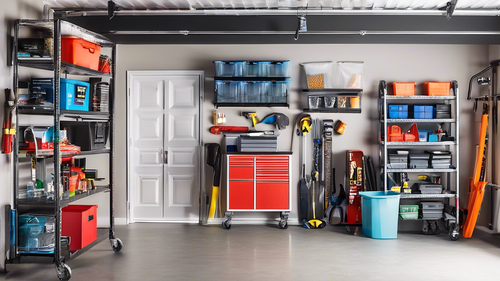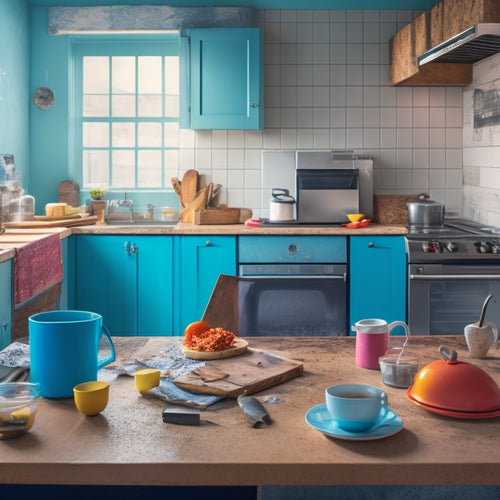
Path to a Clutter-Free Life Uncovered
Share
You're ready to break free from clutter and uncover a life of clarity and calm. Start by defining what a clutter-free life means to you and envision the benefits it will bring. Then, adopt a mindset shift to overcome emotional attachment and develop effective decluttering techniques. Sort items into keep, donate/sell, and discard piles, and surround yourself only with items that spark joy. Next, organize and categorize items, utilizing storage solutions wisely. To maintain your progress, set aside time each week for maintenance and review your organization systems regularly. Now, take the next step towards a clutter-free life.
Key Takeaways
• Define what a clutter-free life means to you and set intentions to achieve it, envisioning the benefits it will bring.
• Adopt a mindset shift to overcome emotional attachment to items and develop effective decluttering techniques.
• Sort and categorize items into keep, donate/sell, and discard piles, surrounding yourself only with items that spark joy.
• Establish routines and habits, such as regular maintenance and the 'one in, one out' policy, to sustain a clutter-free space.
• Create accountability and reward systems to reinforce decluttering habits and acknowledge small wins to stay motivated.
Start With a Clear Vision
To create a clutter-free life, you must first define what that means to you and envision the benefits it will bring. This clarity will serve as your guiding light throughout your journey. Start by setting intentions and using visualization techniques to vividly picture your ideal life. What does your clutter-free space look like?
How does it feel to live in it? What're the benefits you'll experience, such as reduced stress or increased productivity?
Next, cultivate mindfulness practices that help you stay present and focused on your goals. Regularly take a few minutes to meditate, breathe deeply, or practice gratitude. This will help you stay committed to your vision and avoid distractions.
Now, set specific, achievable goals for yourself, breaking them down into smaller, manageable tasks. This will give you a sense of control and direction. By doing so, you'll be well on your way to creating a clutter-free life that aligns with your values and aspirations.
Purge and Let Go Easily
With your clear vision and achievable goals in place, it's time to address the physical aspect of clutter by letting go of items that no longer serve you.
This is where the rubber meets the road, and you'll need to adopt a mindset shift to overcome emotional attachment to your belongings. Recognizing that holding onto clutter isn't just physically draining but also mentally exhausting is crucial.
To purge and let go easily, you'll need to develop effective decluttering techniques. Start by sorting items into three piles: keep, donate/sell, and discard. Be honest with yourself about each item, and ask if it aligns with your vision of a minimalist lifestyle.
Remember, the goal is to surround yourself with only what sparks joy and serves a purpose. By letting go of the rest, you'll create space for new experiences, relationships, and opportunities to flourish.
While decluttering, concentrate on the benefits of a clutter-free life, and you'll find it simpler to release the emotional attachment to your possessions.
Categorize and Group Similar Items
Now that you've purged your unwanted items, it's time to categorize and group similar items together.
You'll need to sort through what's left and separate items into categories, such as 'keep,' 'donate,' and 'store.'
Sort and Purge Items
You'll find it's much easier to decide what stays and what goes when you categorize and group similar items together, like all cleaning supplies in one spot or all books on one shelf. This step helps you visualize the volume of items you have and identify patterns, making it simpler to purge what's unnecessary.
Be honest with yourself - do you really need five identical coffee mugs or three broken appliances? As you sort, acknowledge your emotional attachment to certain items. Ask yourself if keeping them aligns with your goal of a minimalist lifestyle. If not, consider letting them go.
Don't get caught up in sentimentality; remember, the memories attached to an item are what's truly important, not the physical object itself. By releasing these items, you're not erasing the memories, but rather creating space for new experiences and a more streamlined life.
As you sort and purge, keep your end goal in mind: a clutter-free life that sparks joy and efficiency.
Designate Storage Spaces
Assign a home for each group of similar items, ensuring they're stored in a logical and accessible location that makes sense for your daily routine. This means grouping like items together, such as all cleaning supplies in one area or all kitchen utensils in another.
Once you've categorized and grouped your items, it's time to designate storage spaces for each group. To maximize your storage capacity, utilize vertical space by installing shelves or storage units that go up to the ceiling. This will help keep your floors and surfaces clear and create a sense of openness in your space.
Additionally, utilize hidden storage options like decorative storage bins or ottomans with storage compartments. These will help keep items out of sight while still keeping them accessible.
Remember to store items in a way that makes sense for your daily routine. If you use something frequently, store it in an easy-to-reach location. If you rarely use an item, consider storing it in a harder-to-reach location or considering letting it go altogether.
Assign a Home for Everything
Every item in your living and work spaces should have a designated spot where it's stored when not in use, making it easy to find what you need and preventing clutter from building up. This means you'll need to think carefully about how you organize efficiently and where you'll store each item.
Start by categorizing items into groups, such as 'office supplies' or 'kitchen utensils.' Then, assign a specific storage solution to each group. For example, you might use a desk organizer for office supplies or a utensil holder for kitchen items. Be sure to choose storage solutions that are functional and easy to access. This will encourage you to put things back in their assigned spot after use, keeping your space clutter-free.
Create a Maintenance Routine
To guarantee your newly organized space stays clutter-free, set aside a specific time each week to maintain your system and tackle any messes that may have accumulated. This could be as simple as dedicating 30 minutes on Sunday evenings to tidy up and prep for the week ahead. Effective time management is key to maintaining your space, so choose a time that works for you and stick to it.
During this maintenance routine, take a few minutes to review your organization systems and make any necessary adjustments. Check that everything is still in its assigned home and make sure you're not accumulating clutter in any areas.
This is also a great opportunity to practice good organization tips, such as putting things back in their place as soon as you're done using them and avoiding clutter hotspots like countertops and floors. By incorporating this weekly maintenance routine into your schedule, you'll be able to enjoy your clutter-free space for the long haul.
Designate a Place for Daily Items
By designating a specific spot for daily essentials like your keys, wallet, and bag, you'll save time and reduce stress by always knowing exactly where to find what you need. This simple habit is key to maintaining a clutter-free life.
Start by designating a spot near your entryway for your keys and wallet, making it easy to grab them on the go.
In the kitchen, assign a specific drawer or container for utensils and gadgets, keeping them organized and within reach.
In the bathroom, utilize storage bins and baskets to keep toiletries and linens tidy.
When it comes to bedroom decluttering, designate a spot for your bag and shoes, keeping them off the floor and out of the way.
By creating a home for each item, you'll avoid clutter buildup and make your daily routine more efficient.
With a designated spot for everything, you'll be able to focus on more important things – like enjoying your clutter-free life.
Implement the One-Touch Rule
As you start implementing the one-touch rule, you'll find it saves you time and energy in the long run.
When you pick up an item, handle it immediately by dealing with it, filing it, or tossing it.
Handle It Immediately
When you pick up an item, make a decision about it immediately, rather than putting it down and dealing with it later. This is the core principle of the one-touch rule, a game-changing strategy for achieving a clutter-free life.
Declutter as You Go
You'll find it helpful to declutter as you go about your daily routine, tackling clutter hotspots like your mailbox, kitchen counters, or entryway. By adopting a declutter mindset, you'll cultivate a minimalist lifestyle that's free from unnecessary clutter. This habit will become second nature, allowing you to maintain a clutter-free space with minimal effort.
To implement the one-touch rule, make a conscious decision to handle each item only once. When sorting through mail, for instance, immediately categorize it as 'keep,' 'recycle,' or 'toss.' This simple habit will save you time and energy in the long run.
Similarly, when cooking, clean as you go, putting away utensils and ingredients after each use. This approach will prevent clutter from building up and make cleaning a breeze.
Use Storage Containers Wisely
Designate a specific area or shelf for your storage containers to make sure they're easily accessible and don't contribute to clutter. This will help you maintain a sense of container organization, maximizing space and keeping your belongings tidy.
When selecting storage containers, choose ones that fit your specific needs. Consider the size, material, and shape of the container based on what you'll be storing. For instance, use clear plastic bins for items you need to see, like toys or craft supplies, and label them accordingly.
Implement a labeling system to guarantee easy access to what you need. You can categorize containers by room, activity, or type of item. This will save you time and frustration when searching for something.
Remember to keep your storage containers clean and dry to prevent moisture buildup and pest infestations. By following these simple tips, you'll be able to efficiently store your belongings, freeing up space and reducing clutter.
Establish Boundaries With Clutter
Set clear limits on what enters your space by adopting a 'one in, one out' policy, where every new item that comes in necessitates the removal of an old one. This mindset helps you maintain a balanced amount of possessions and prevents clutter from building up. By setting boundaries, you're more mindful of your shopping habits and avoid impulse buys.
| Boundary | Benefits |
|---|---|
| One in, one out | Maintains balanced possessions, prevents clutter |
| Limited storage space | Encourages intentional purchasing, reduces waste |
| Regular decluttering sessions | Frees up mental energy, reduces stress |
| Saying no to freebies | Avoids unnecessary items, saves time |
Establishing these boundaries helps you develop a decluttering mindset and creates clutter-free habits. You'll be more intentional about what you bring into your space, and you'll maintain organizational boundaries that keep your life running smoothly. By setting these limits, you'll be more mindful of your consumption habits and make conscious decisions about what you allow into your life.
Maintain Your Newfound Freedom
With your new decluttering habits in place, creating systems and routines is vital to maintain your clutter-free space over time. You've worked hard to get to this point, and it's crucial to keep the momentum going.
To make sure you continue on this path, implement the following strategies:
-
Schedule daily reminders to maintain your space and address any clutter that may be accumulating.
-
Set up an accountability partner system where you and a friend or family member check in with each other weekly to discuss progress and challenges.
-
Establish a reward system to positively reinforce your decluttering habits. Treat yourself to something nice when you reach a milestone, like a clutter-free week or a successful donation run.
- Acknowledge small wins along the way to keep yourself motivated and encouraged.
Frequently Asked Questions
How Do I Stay Motivated During the Decluttering Process?
"You'll need a million reminders to stay motivated, but seriously, a mindset shift towards embracing the process helps! Find an accountability partner, implement a reward system, and track progress to celebrate small wins along the way."
What if I'm Decluttering With a Family Member Who Resists Change?
When decluttering with a resistant family member, you're dealing with resistance, so find ways to compromise and involve them in the process. Effective communication strategies and understanding family dynamics will help you navigate this challenge.
Can I Really Get Rid of Sentimental Items Like Childhood Photos?
You're hesitant to part with sentimental items like childhood photos, but remember, their emotional attachment lies in the memories, not the physical object. Try digitizing them, and during the decluttering process, implement organizing strategies to honor their sentimental value.
How Often Should I Review and Adjust My Clutter-Free Systems?
'Did you know 80% of clutter returns within a year if not maintained? You'll secure long-term success by scheduling regular maintenance, tracking progress, and making adjustments to your systems, guaranteeing sustainability and a clutter-free life.'
What's the Best Way to Handle Clutter That's Inherited From Others?
When dealing with inherited clutter, you'll need to set boundaries with family members and manage the emotional impact. Practice letting go by acknowledging the guilt, then release it, and focus on creating a clutter-free space that reflects your values.
Related Posts
-

Garage Workbench Organization
Garage Workbench Organization: A Guide to Maximizing Space and Efficiency Are you tired of a cluttered and unorgan...
-

Garage Organization on a Budget: Clever Tips and DIY Solutions
Does your garage resemble a chaotic jumble of forgotten belongings and outgrown equipment? Fear not, garage enthu...
-

Kitchen Renovation Cost Estimates Made Easy
You're about to commence a kitchen renovation expedition, and getting a handle on the costs is essential to avoiding ...


